Multiplex ParkMaster Pro
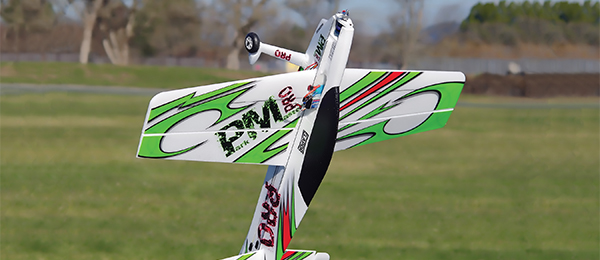
Written by Josh Bernstein This electric-powered 3-D/aerobatic model is a real performer Product review Photos by Jon Barnes Read the full product review in the March 2016 issue of Model Aviation.
Specifications
• Model type: Electric 3-D/aerobatic ARF • Skill level: Intermediate to advanced • Wingspan: 38.375 inches • Wing area: 450 square inches • Length: 40.5 inches • Wing loading: 5.9 ounces per square inch • Weight: 18.4 ounces • Power system: Brushless electric outrunner • Radio: Minimum four-channel 2.4 GHz transmitter • Construction: Elapor foam • Street price: Kit Plus $205.99; Kit $103.99Test-model Details
• Motor used: Himax HC2816 1220 Kv brushless outrunner (included) • ESC: Hitec Energy Sport 20-amp air ESC (included) • Battery: Turnigy nano-tech 3S 850 mAh LiPo • Propeller: APC 10 x 4.7 Slow Flyer (included); Xoar 10 x 6 • Radio system: Spektrum DX6 six-channel 2.4 GHz transmitter; Spektrum AR400 four-channel 2.4 GHz receiver • Servos: Four Hitec HS-65HB+ nano-Karbonite micro servos (included) • Ready-to-fly weight: 19 ounces • Flight duration: 5 to 7 minutesPluses
• Lightweight, rigid, and durable Elapor foam. • Low wing loading allows for slow, stable maneuverability. • Impressive high-energy tumbling. • Excellent performance with included power kit.Minus
• Noticeable slop at servo horns because of use of Z-bends.Product Review
Based in Germany, Multiplex has been an industry leader in the world of RC flight with a wide range of aircraft. Designed by German indoor aerobatics champion, Martin Muller, the original ParkMaster 3D was released more than seven years ago to great success. The ParkMaster quickly gained the respect and admiration of RC pilots from around the globe. Nearly eight years later, Multiplex is looking to expand on its previous success with the minimally (although expertly) redesigned ParkMaster Pro. Although the ParkMaster Pro shares much with its predecessor, there are some important improvements. Utilizing carbon-fiber upgrades shaves precious weight while increasing strength, resulting in a lighter, more rigid airframe. In the world of foam profile 3-D airplanes, a small reduction can represent a significant drop in wing loading—that magical number that determines much of how well a 3-D airplane performs. To increase performance, Multiplex has released an upgraded power package with a higher-rpm version of the trusted Himax 2816 brushless outrunner (1,220 Kv versus 890). With a redesigned motor mount that can accept an even larger motor (as well as allow a wide range of thrust-angle adjustments), Multiplex has invited pilots to explore the limits of the ParkMaster Pro’s extremely rigid airframe. In other words, the new ParkMaster Pro is lighter, stronger, and more powerful.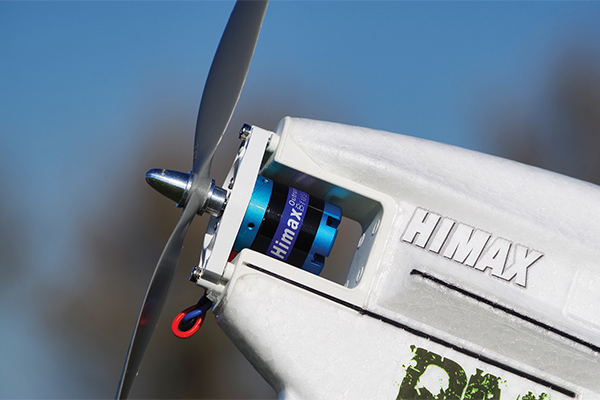
The upgraded Himax 1,220 Kv motor provides plenty of power for aggressive 3-D maneuvers and unlimited vertical performance.
It’s also better looking. With a completely redesigned graphics package, the ParkMaster Pro makes much more of a statement than its predecessor, and its design is modern and aggressive. Because maintaining visual orientation is a priority when flying 3-D, the airplane’s upgraded look is easy to see at a distance and when transitioning from one orientation to another. Slightly shy of 40 inches long, with a wingspan a little more than 38 inches, the ParkMaster Pro has an impressive wing area of 450 square inches. A weight of less than 19 ounces results in a wing loading of approximately 5.9 ounces per square foot—that’s low. The airplane is floaty and capable of stable, post-stall flight, without giving up much in the area of tracking and precision. And when it comes to violent tumbles—forget about it! Like many Multiplex models, the ParkMaster Pro comes in two versions: Kit and Kit-Plus. The former is only the airframe and requires the builder to supply a motor, ESC, servos, and propeller. The latter provides the airframe along with a set of exhaustively tested components. The ParkMaster Pro shares many attributes with traditional, profile 3-D airplanes with its low wingloading and slow, floaty flight characteristics, minimal structure, and ease of repair, but there are some important differences. Many airplanes in this category are constructed of either EPP or Depron foam. The ParkMaster Pro utilizes a single-piece fuselage made from Multiplex’s popular Elapor foam—a proprietary foam blend that is lightweight, stiff, and easy to repair.
Construction
If you’ve never built a Multiplex kit before, you are in for a treat. The quality of the parts and the clarity of the instruction manual make the build process as pain-free as possible. As is the case with most quality manufacturers, Multiplex packs its airplanes mindfully. The ParkMaster Pro arrived in a box with its parts wrapped and separated to keep pieces damage free during their journey. After removing and identifying each piece and checking each control surface for warp, I could not find a single thing to complain about. Should you find that a piece has developed a warp, one of the benefits of Elapor foam is its ability to retain its original shape. Simply bend it gently back slightly past neutral, and it will straighten itself out. Multiplex formats its manuals so it is easy to remove the illustrations so they can be laid out next to the text to provide visual context and guidance during assembly. The clear, straightforward text and images leave little room for confusion. Here are a few recommendations for the building process: To achieve the full visual effect of the ParkMaster Pro’s newly designed look, Multiplex recommends painting the faux canopy area black. When painting foam it’s important to use many thin coats because the solvent in paints can damage your airplane if applied too heavily. Multiplex recommends Zacki Elapor glue. This medium CA glue doesn’t require the use of an accelerant or kicker. Although Zacki adhesive might be preferable, it’s only available in Europe, so any medium CA glue will work. Scuffing the foam surfaces with 300-grit sandpaper before gluing will help with adhesion, as will pilot holes made with a toothpick, allowing the glue to anchor. Although the ParkMaster Pro uses easily adjustable quick-connects at the control surface horns, they were not utilized at the servo horns. Instead, a Z-bend is used and, with the small gauge of the control rods, there is noticeable slop present. A little slop won’t hurt, but ultimately an airframe is only as good as its control linkages, and taking the time to reduce that slop will pay off with a cleaner-flying airplane. A common approach is to put a thin coat of oil on the Z-bend, insert it into the horn, and then apply a small drop of CA glue into the hole. When cured, you have a tighter fit with reduced slop that you can still “break” free, if needed. Because the ParkMaster Pro is designed for aggressive 3-D tumbling, the main wing must be extremely rigid. This requires a specific process of gluing in the spars where the wing is preloaded, increasing strength and rigidity. Take care to precisely follow these steps because nothing will ruin your day faster than showing off to your friends with a full-throttle blender, only to see your airplane’s wing do the “backward clap.” Absent from the ParkMaster Pro is a steerable tail wheel or skid. Because the ParkMaster Pro will often be flown off of grass or hand launched, the foam on the bottom of the rear fuselage and rudder should hold up. There are countless do-it-yourself approaches to protecting your shiny new ParkMaster Pro should you find yourself taxiing across a parking lot or other rough surface. One of the simplest—and perhaps lightest—options is to cut a piece of a zip tie (the 8- to 10-inch ones are thick enough), fold it to create a nickel- or quarter-size loop, and hot glue or CA glue it in place slightly forward of the rudder. The ParkMaster Pro’s massive rudder allows for easy ground steering, with the zip-tie loop sliding frictionless along any surface.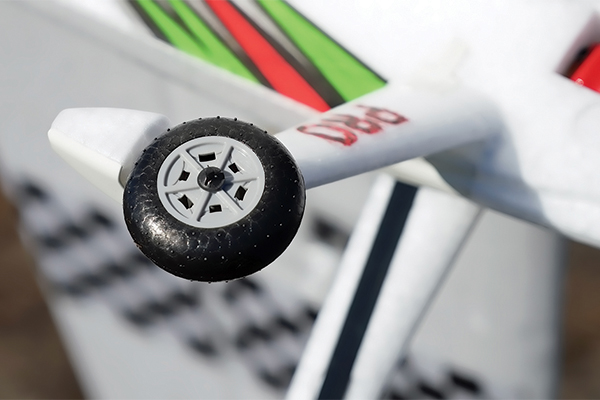
The wheel pants are designed to allow the airplane to take off and land on grass without nosing over. The carbon-fiber landing gear has foam fairings.
Throughout the airframe, Multiplex has provided servo lead grooves that facilitate the building process, but also enhance the clean, tight look of the airplane. The rudder, elevator, ailerons, and ESC all have their own lane on the freeway of wires, making their way to the centrally located receiver slot. Discussing ESCs, Multiplex doesn’t merely give you a strip of Velcro to slap against the side of the fuselage (like many other profile foamies). The provided slot for the ESC positions it securely within the airframe and flush with the fuselage, eliminating drag while maximizing airflow over the heatsink.
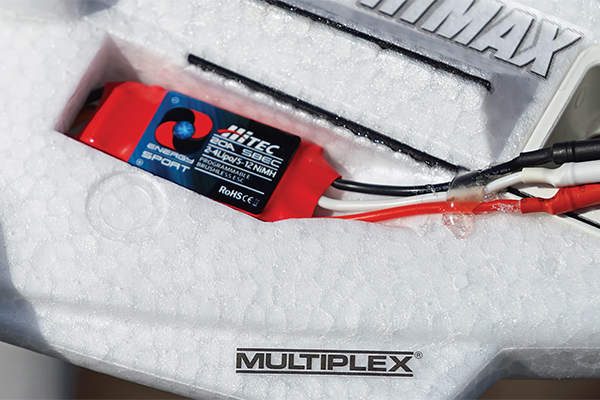
The Hitec ESC fits neatly in the slot in the fuselage and keeps it flush, providing good airflow for cooling.
The battery and servo leads exit and are guided to the receiver and battery locations, respectively. These finishing touches are another way that the ParkMaster Pro and Multiplex stand out. For many builders, the application of graphics is a final step with almost sacred importance. This process can transform your recently completed airplane from monotone white to a multicolored, electron-breathing, gravity-mocking machine. You will find two sheets of stylized decals included. No cutting is necessary—simply peel and stick. The sticker sheets are laid out by location, which helps keep their application clean and organized. The designs appear to have more in common with alien weaponry from a big-budget movie, curving and slashing their way across the stark, white backdrop. In terms of the ParkMaster Pro’s graphics package, I have yet to find its equal.
Flying
Late fall weather is not ideal for testing a small 3-D airplane—or so I thought. After spending some time with the ParkMaster Pro, I’ve placed it high on my list of must-have winter airplanes—as well as spring, summer, and fall. Its compact size, durable construction, inexpensive batteries, and wide flight envelope make it perfect for tossing in the backseat with a handful of batteries and going to a park or school for some wild shenanigans. Start the fun with some controlled, stable, precise flying then flip that switch to high rates for some wickedness. During the initial flight testing, I utilized a range of batteries and propellers to get a sense of the ParkMaster Pro’s comfort zone. Although Multiplex recommends a three-cell 950 mAh LiPo battery and a 10 x 4.7 propeller, I began with a shiny new Xoar Beechwood 10 x 6 propeller and a slightly larger 1,300 mAh LiPo battery. The ParkMaster Pro’s battery slot allows for several battery sizes (after the central foam block is removed), and with the 1,300 mAh battery all the way toward the slot’s rear, the airplane balanced right around the front of the recommended 110mm to 120mm center of gravity (CG) range. Launching the ParkMaster Pro can be accomplished however you’d like, although this is an airplane that excels at Short Takeoff & Landing (STOL). A quick burst of throttle and the model is airborne before you can say, “Hey, check this out.” Of course, with the massive canopy area sitting there like a handle, hand launching the ParkMaster Pro is an attractive option. With the throttle at roughly 50%, I released the ParkMaster Pro into the gentle wind and began making minor trim adjustments. Little trim was required, and I quickly settled in to appreciate the airplane’s tracking and sport mannerisms. With its shorter tail moment, the ParkMaster Pro’s pitch authority is intense, and sport flying on higher rates is not recommended. With the elevator set to 40%, ailerons to 50%, and rudder to 70% (all with moderate exponential), the ParkMaster Pro felt docile and seemed willing to spend the day carving clean holes in the sky. With massive control surfaces, it seemed likely that the ParkMaster Pro would respond quickly in the air, but I had no idea it would be that responsive. With its huge rudder extending above and below its elevator, the ParkMaster Pro has startling yaw authority. Combining that rudder with a significant side area makes flying the ParkMaster Pro in knife-edge flight a no-brainer. With the heavier-than-intended battery, the airplane was slightly nose-heavy, requiring a little more down-elevator during inverted flight than I would have preferred, so I programmed in a knife-edge mix to reduce the rudder-to-elevator coupling. I adjusted battery position and used lighter-weight batteries, so I was able to achieve a more neutral CG, and the coupling was reduced.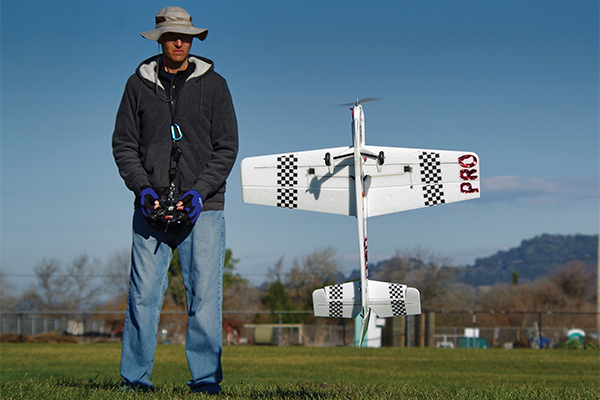
The ParkMaster Pro has stability for low-and-slow maneuvers. It’s stable in post stall, allowing for low hovers and tail touching if you dare.
Because the contrast between its top and bottom is so stark, and its knife-edge mannerisms so pleasing, I found myself flying repeated knife-edge patterns, with quick rolls alternately providing me and the growing crowd of drooling fliers behind me views of the ParkMaster Pro’s front and backside. In preparation for 3-D flight, I used a slightly smaller 3S 850 mAh LiPo battery along with an APC 10 x 4.7 Slow Flyer propeller. The combination of a lighterweight battery and the higher thrust from the Slow Flyer’s wide, low-pitched blades resulted in awe-inspiring punch-outs and an increase in post-stall stability. The ParkMaster Pro’s low, slow capabilities really shined. Hovers were surprisingly stable and torque rolls could be started and stopped at will. Harriers (particularly inverted) are stable and invite ever-lower passes. With most lightweight, profile 3-D airplanes, low wing loading comes at a cost. Many of the more popular—and violent—3-D maneuvers require inertia, which can be accomplished through higher speeds or with a heavier airplane. Because this class of airplane is designed to be stable and controllable at a low airspeed, an increase of weight is self defeating. This leaves speed as the mechanism through which a pilot can get his or her airplane twisted in knots. Although the ParkMaster Pro is reasonably fast for its type, what really makes it stand out is how quick it is. The high power-to-weight ratio allows a pilot to sling the ParkMaster Pro into maneuvers. Many airplanes in this class can perform well during high-energy tumbling—build some speed, mash the sticks, and see what happens. That’s all good, but most experienced pilots are looking for more than a one-dimensional airplane. The ParkMaster Pro distinguishes itself is in its ability to transition smoothly from precision and sport flight, to low-and-slow hovers and Harriers, and finally on to high-energy, high-inertia maneuvers. Not only does the ParkMaster Pro have a wide flight envelope, there is a crispness that makes these transitions more inviting.










3 comments
Parkmaster Pro
Multiplex parkmaster(s)
Parkmaster Pro review
Add new comment